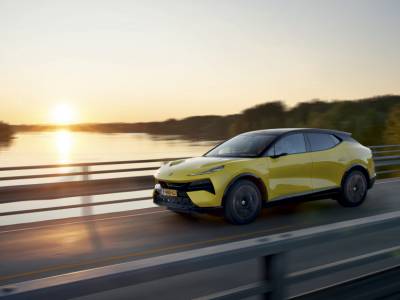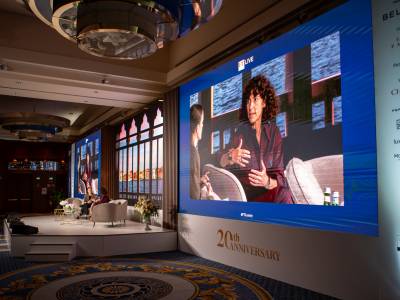The Eletre arrives after upheaval and change at the Norwich-based company. Shifts in ownership, legislation, strategy and technology have all conspired to straiten Lotus’s niche of compact sports cars; for the company to thrive in a new automotive era, it had to do things differently.
Inside the Lotus Eletre Global Launch
5th October 2023
Join Jonathan Bell for the Global Launch of the new Lotus Eletre as it marks a radical departure for the British sports car maker. The company’s first production electric vehicle and first four-door SUV, the Eletre (el-e-tra) appears so far removed from Lotus’s iconography and heritage that questions have been asked about the car’s right to wear the storied badge.
Presented by Lotus
This is the result. Ushered into existence through co-operation with Lotus’s new majority owners, the Chinese industrial conglomerate Geely, the new Eletre blends the best of many worlds. Designed at the company’s Coventry design studio, engineered at Geely’s German technical centre, manufactured in Wuhan, China, the Eletre is described by Lotus as ‘Born British, Raised Globally’
Having revealed the Eletre to the world in 2022, Lotus chose Norway for its global media launch. The land of Munch, Ibsen, deep, dark forests, 24-hour nights and the enduring legend of the troll is a surprising place to find a sunny yellow electric Lotus. Norway also isn’t known for its automotive culture. It’s a country where bus, train and bicycle are favoured and the car is tolerated, rather than celebrated (although there’s a flourishing classic car scene).
However, one thing Norway does have is electricity, and plenty of it. Hydroelectric power generates 92% of the country’s supply, with other renewables accounting for 6%. Norway is rich from its huge reserves of fossil fuels and invests the money in cleaning and greening its infrastructure. That extends to electric cars and — crucially — chargers. Last year, 79% of the cars sold in Norway were electric, the biggest percentage in the world.
One of the pillars of the Eletre is its towering performance, which is hard to explore on Norway’s picturesque, winding but very slow country roads. But proximity to plentiful clean, green electricity make this a natural habitat for such a car, unashamedly aimed at families game for enjoying the great outdoors. The venue for the launch was The Well, one of Norway’s most acclaimed spa retreats. Opened by local entrepreneur Stein Erik Hagen in 2015, The Well sits in a wooded location about 13km south of Oslo. It’s a crisp, cleanly detailed modern building, combining the original spa with a new 104-room hotel, which followed in 2021. There are two bars and two restaurants, one of which, Mori, has spectacular treetop views.
In the Biblioteket Bar, we sipped cocktails that made the most of locally sourced spirits; the Lotus Martini (Ketel One vodka, Nuet aquavit, Lillet Blanc, yellow chartreuse, grapefruit bitters) and the Electric Sour (Skagerrak gin, maraschino, orange curaçao, Acqua Bianca and lemon). The food, too, was inspired by a blend of local ingredients and global flavours. Mori’s head chef Richard Bocarro’s five-course menu of beautifully presented Asian fusion dishes added a flavoursome twist to Nordic favourites like seafood, such as Thai curry foam and mango sorbet in a lobster and leek risotto.
The Well is delightfully Nordic. The complex is vast, covering 10,500 square metres, with 25 individual treatment rooms, as well as a Japanese bathhouse, traditional hamam and a number of different saunas, each based on different national traditions, including those of Finland and Japan.
Away from the hotel, we finally got the chance to sample the Eletre on the open road. A gentle drive through the undulating farmland of southern Norway, with its neat falu red painted farmhouses and raised barns, shows a softer, less grandiose side of the country’s landscape. On these smooth surfaces and shallow curves, the Eletre felt as though it could give far more than the unhurried pace of local life, as if there was a sports car trying to get out from underneath the faceted bodywork.
Besides iconic models such as the Elan, Europa, Elite, Elise and the Esprit, Lotus has carved a lucrative sideline as an engineering consultant, fettling and refining the ride, handling and other elements of countless cars from other marques. That expertise has been parlayed into the Eletre, which rides and turns with grace and deportment, adaptable air suspension effectively cloaking the tremendous mass of its 112kW battery. Weighing more than an entire 1957 Lotus Seven, the power pack sits at the base of the Eletre’s chassis, giving it the low centre of gravity that’s fundamental to good handling.
Happily, Lotus recognised the limitations of Norway’s sedate road network and booked us a session at the Eggemoen Aviation and Technology Park, where the broad runway doubles up as a track for us to explore the top spec Eletre R model. With a zero to 62mph time of under three seconds, Lotus claims that the Eletre R is the “world’s fastest dual-motor pure electric SUV.” This is slicing the categories rather finely, and although acceleration of this magnitude is an exhilarating experience, most buyers would be better off with a less powerful specification. As with all current EVs, you can have speed or range, but not both. To achieve the Eletre’s impressive 373-mile range, you’ll have to feather the throttle, switch off the aircon and opt for the smallest 20” wheels, not the standard 22” items.
Smaller wheels undermine the car’s visual impact, which is a shame, as the Eletre is a striking machine. Physically imposing at over 5m in length, it’s longer than an Aston Martin DBX or a Range Rover. The Eletre’s designers have cleverly cloaked this bulk with surfaces that seem to lower and elongate the shape, aided by deep, aerodynamically beneficial fissures that further break up the forms. Add in clever details like the active front grille with its matrix of triangular petals that open or close depending on heating and cooling requirements, and you have a car that is compellingly different, if not objectively beautiful.
The Eletre’s interior is a unqualified success. Essential information goes into a narrow screen ahead of the driver, with Lotus’s new infotainment system, Lotus Hyper OS, operated from a large centrally mounted touchscreen. This ‘digital cockpit’ is intuitive and swift, lacking only the haptic feedback of the Porsche Taycan. The balance between on-screen controls and physical buttons is not quite as equitable as the Porsche’s, but ensures that key functions are at the fingertips, without requiring a dangerous look down from the road ahead.
Those stolen glances will be a thing of the past once the Eletre’s suite of self-driving technologies finally comes online. The car is festooned with sensors, cameras and LiDAR systems, but the capacity for ‘true’ self-driving won’t be switched on just yet. Some markets are more advanced than others, but autonomy is multi-tiered and complex, so you can expect a long-drawn-out path to legislative freedom. Whatever happens, the Eletre’s electrical architecture and processing power are ready and waiting; only the software (and the law) needs to change.
As the company is founded on the mythos and celebration of the talent of individual drivers, engineers and technicians,
Lotus’s enthusiasm for autonomous driving feels weirdly off-brand. Then again, so is the idea of a Lotus as a ‘lifestyle vehicle’, rather than an out-and-out lightweight sports car for the enthusiast.
Nevertheless, the new Eletre is a hugely competent car that goes far above and beyond pure functionalism and simplicity. As the sun set over the Nordic pines, blended and branded Lotus cocktail in hand, we reflected on this new chapter in the 75-year-old brand’s story. The Lotus Eletre is not a ‘normal’ Lotus. For purists, perhaps it’s an innovation too far. But for those of us who favour a trip to the quietly sublime over the path of raw intensity, the Eletre is a welcome first step on the journey.
Lotus Eletre, from £89,500













